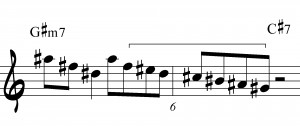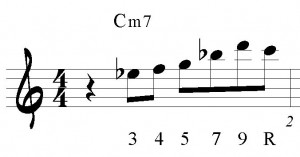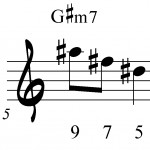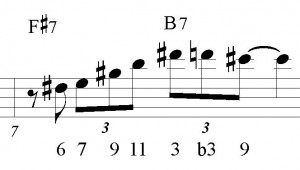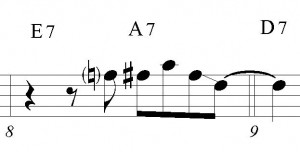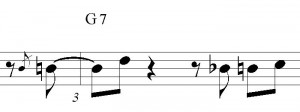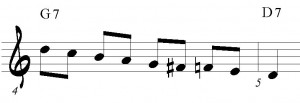Before Wes Montgomery was “The Incredible Jazz Guitar[ist]” and “Smokin’ At the Half Note” he began his professional career on the road as guitarist in the Lionel Hampton Big Band from 1948 to 1950. Wes Montgomery was drawn to the six-string electric guitar (as nearly every guitarist at the time was) via Charlie Christian. As Montgomery states, he heard Christian playing “Solo Flight,” Charlie’s signature feature with the Benny Goodman Orchestra, in 1943 and “didn’t look at nobody else.” Montgomery would spend the next eight months learning Christian’s solos note-for-note. A few months later, at the age of 20, Montgomery was playing Charlie Christian solos for the crowd listening in Indianapolis’ 440 Club. Once the audience was so excited about what Wes was playing they cheered for more, but Wes said he couldn’t because that was all the Christian solos he knew. 
Over the next five years Wes Montgomery would continue to gig night after night, developing his own voice from Christian’s foundation. In May 1948 Wes auditioned for Lionel Hampton, who happened to be passing through Indianapolis, and was hired to be his guitarist. Hampton, who was a member of the Benny Goodman Sextet with Charlie Christian in 1939, stated that even though Wes could not read music, he was impressed with Montgomery’s ability to play lines like Charlie Christian. Montgomery would leave Hampton’s band in 1950, but Montgomery did make a few recordings while with Hampton. These recordings unique in that Wes Montgomery would not be heard on a recording again until 1957.
Although Montgomery toured and recorded with Hampton’s band, he was not a featured soloist on many recordings. Two rare recordings that allow us to hear what Wes sounded like during this time are “Adam Blew His Hat” and “Brant Inn Boogie.” “Adam Blew His Hat,” recorded July 1, 1948 in New York, is a medium-up swing number in which Montgomery is given an eight bar solo. Although Christian’s influence is present, Montgomery’s originality is showing even in these eight bars. Like Christian, Montgomery’s use of scales in his improvisations is not overwhelming and he favors arpeggios.
Over the minor harmonies, Cm7 (measure one to two) and G#m7 (measures five to six), Montgomery plays a descending Dorian mode, the diatonic second mode of the major scale.
Montgomery begins in measure one, over a Cm7, by arpeggiating up an EbMaj7 chord over the Cm7. Montgomery is treating the Cm7 as an EbMaj7 with C in the bass. This approach allows him to emphasize the following chord tones: the third (Eb), fifth (G), minor seventh (Bb) and ninth (D). Arpeggiating up from the third of a chord was also a device favored by Christian.
Over the G#m7 in m. 5, Wes descends from the ninth (A#) down to the fifth (D#).
Montgomery also emphasizes the upper chord tones of the harmonies in measure seven over the F#7 to B7. Montgomery outlines an EMajor7 arpeggio with a passing chromatic D-natural to the C#. Over the F#7, Montgomery plays all upper chord extensions beginning with the sixth (D#), flat-seventh (E), ninth (G#), and eleventh (B). Over the B7 he plays the third (D#), flat-third (D), and ninth (C#).
Charlie Christian regularly used the passing flat-third down to the ninth and this technique appears have been added into Montgomery own vocabulary. Montgomery ends his solo by anticipating the D7 in measure nine and adds a bluesy touch by beginning on the F-natural (flat-third) into the F-sharp (natural-third).
“Brant Inn Boogie” was recorded a few weeks later on July 21, 1948 in New York. “Brant Inn Boogie” solo progression is a blues in C, in which Wes is given a chorus and a half to improvise over. Montgomery begins with a very simple melodic phrase over the C7, going between the fifth (G) and flat-seventh (Bb) before resolving to the B-natural (the third) in measure two over the G7.
“Brant Inn Boogie” contains several elements that could be traced back to Montgomery’s study of Christian’s solos including playing the raised second to the third and use of the bebop dominant scale. Montgomery uses the raised second (or flat-third) to the third motive in measures two and three, and in fourteen.
In measure fourteen, Montgomery adds tension by anticipating the change to G7 by two beats.
In measure four, Wes descends a G dominant bebop scale, inserting the F-sharp between the root (G) and flat-seventh (F).
Wes Montgomery was a master at creating long, melodic sequences in many of his most classic solos, “Brant Inn Boogie” is no different. In measures nine through thirteen Montgomery creates a sequence over the I (G7) and IV (C7) chords using the G minor pentatonic (G, Bb, C, D, F). Montgomery is able to create tension by using a rhythmic ostinato beginning on the root of the G7 (m. 9) and ending on the root of the C7 (m.13). Even in these early solos one can see that Wes Montgomery truly focused on creating a statement with his melodies.
Wes also used techniques associated with bebop like enclosure and harmonic substitution in measures 17 and 18. Over the D7, Wes encloses the C (flat-seventh) and then arpegiates up a C7 chords, ending with a chromatic run from the Bb up to the D. The C7 arpegio played by Montgomery hints at a V-IV cadence as he resolves with an anticipation to the tonic G7 chord in m.18. Anticipating a chord change was another technique found in Charlie Christian’s playing and would also be a technique that would be prominent in Bebop.
These rare examples of Montgomery’s playing in 1948 while with the Lionel Hampton Big Band show that Montgomery was applying melodic techniques that could be credited to his imitation and assimilation of Charlie Christian’s playing. Even at this fairly early stage, Montgomery was not a Christian clone in any way. Montgomery was already using techniques like outlining upper chord tones, chromatic pitches, and harmonic substitutions with his own variations. Montgomery would leave the Hampton band in 1950 and return to Indianapolis to continue working in the jazz clubs of the city. Montgomery would not be heard on a recording for nearly eight years after this. During this time Montgomery would continue to build on the material he imitated from Charlie Christian and continue to assimilate these techniques into a sound that would forever be known as Wes Montgomery’s.
Download PDF copies of:
Adam Blew His Hat pdf
Brant Inn Boogie pdf

